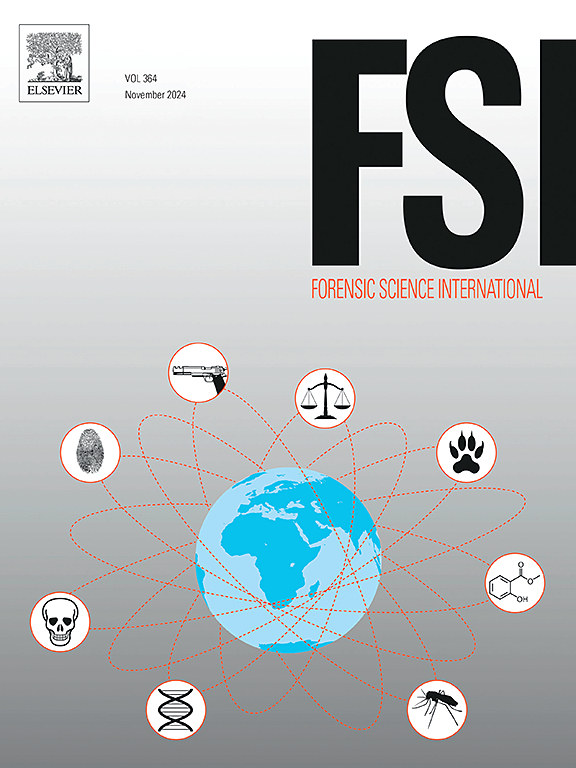单次和多次短时间体内被动暴露于低浓度和高浓度-Δ9-THC-cannabis后头发上的Δ9-tetrahydrocannabinol (Δ9-THC)和大麻二酚(CBD)分析
IF 2.2
3区 医学
Q1 MEDICINE, LEGAL
引用次数: 0
摘要
长时间接触大麻烟雾可能会导致头发中可检测到的大麻素水平上升,使法医头发分析的解释复杂化。接触“轻大麻”,即Δ9-tetrahydrocannabinol (Δ9-THC)含量低、大麻二酚(CBD)含量高的产品,也会导致体外污染。本研究的目的是评估体内短暂、单次和反复被动接触大麻和“轻大麻”是否会产生可检测到的头发水平Δ9-THC和CBD,以及是否可以区分这两种产品。四名志愿者在一个月的时间里,每周15分钟暴露在车内泵输送的低-Δ9-THC(0.5% %)大麻烟雾中。洗脱1个月后,以相同的方案重复暴露,并高-Δ9-THC(5 %)。每次接触后采集毛发和尿液样本。通过液相色谱串联质谱法对Δ9-THC和CBD进行检测,有和没有洗涤步骤(总n = 72)。检测尿液中药物代谢物(LOD: 1.66 ng/ml)。未发现药物在暴露过程中积累。尿检总是呈阴性。在接触少量-Δ9-THC大麻后,洗发样本中CBD呈阳性(平均0.05 ng/mg),而在接触大量-Δ9-THC大麻后,洗发样本中Δ9-THC呈阳性(平均0.02 ng/mg),其水平也是典型的吸毒水平。这两种产品很容易区分。我们的研究表明,即使在短时间接触大麻和“轻大麻”后,体内也可能出现头发污染,这强调了法医毒理学中对头发分析结果进行仔细解释的必要性。本文章由计算机程序翻译,如有差异,请以英文原文为准。
Analysis of Δ9-tetrahydrocannabinol (Δ9-THC) and cannabidiol (CBD) on hair after single and repeated short in vivo passive exposures to low- and high-Δ9-THC-cannabis
Prolonged cannabis smoke exposure could give rise to detectable levels of cannabinoids in hair, complicating forensic hair analysis interpretation. Exposure to “light cannabis”, i.e., products that are low in Δ9-tetrahydrocannabinol (Δ9-THC) and enriched in cannabidiol (CBD), can additionally lead to contamination, as shown in vitro. The aim of the present study was to assess whether detectable hair levels of Δ9-THC and CBD could arise in vivo from short, single and repeated passive exposure to cannabis and “light cannabis” and whether the two products could be distinguished.
Four volunteers underwent weekly 15-minute exposures to low-Δ9-THC (0.5 %) cannabis smoke, delivered by a pump inside a car, over a month. After 1 month of washout, exposures were repeated with the same scheme with high-Δ9-THC (5 %).
Hair and urines samples were collected after each exposure. Hair samples were tested, with and without a washing step (total n = 72), by liquid chromatography tandem mass spectrometry for Δ9-THC and CBD. Urines were tested for drug metabolites (LOD: 1.66 ng/ml).
No accumulation of drugs over exposures was shown. Urines always tested negative. Washed hair samples were positive for CBD (mean 0.05 ng/mg) after exposure to low-Δ9-THC cannabis, and for Δ9-THC (mean 0.02 ng/mg) after exposure to high-Δ9-THC cannabis, with levels also typical of drug use. The two products could be easily distinguished.
Our study showed that hair contamination could arise in vivo even after short single exposures to cannabis and “light cannabis”, underlining the need for a careful interpretation of results of hair analysis in forensic toxicology.
求助全文
通过发布文献求助,成功后即可免费获取论文全文。
去求助
来源期刊

Forensic science international
医学-医学:法
CiteScore
5.00
自引率
9.10%
发文量
285
审稿时长
49 days
期刊介绍:
Forensic Science International is the flagship journal in the prestigious Forensic Science International family, publishing the most innovative, cutting-edge, and influential contributions across the forensic sciences. Fields include: forensic pathology and histochemistry, chemistry, biochemistry and toxicology, biology, serology, odontology, psychiatry, anthropology, digital forensics, the physical sciences, firearms, and document examination, as well as investigations of value to public health in its broadest sense, and the important marginal area where science and medicine interact with the law.
The journal publishes:
Case Reports
Commentaries
Letters to the Editor
Original Research Papers (Regular Papers)
Rapid Communications
Review Articles
Technical Notes.
 求助内容:
求助内容: 应助结果提醒方式:
应助结果提醒方式:


